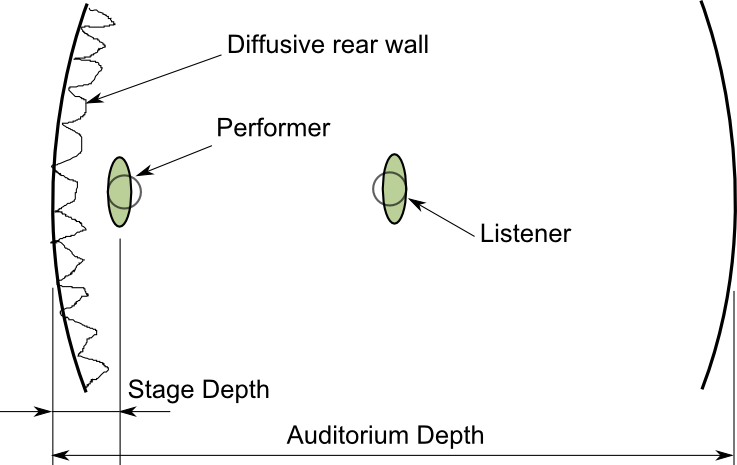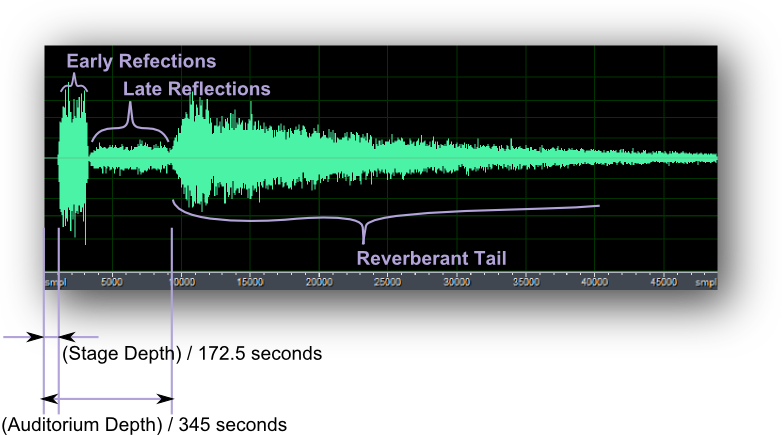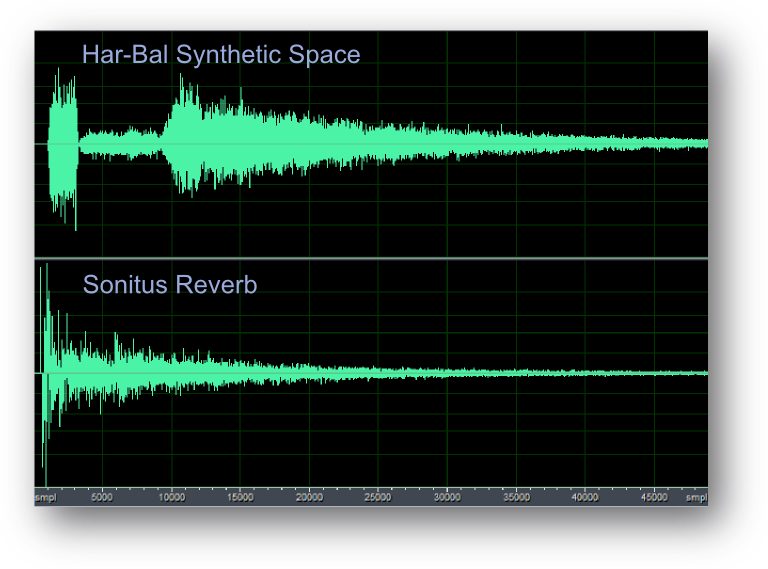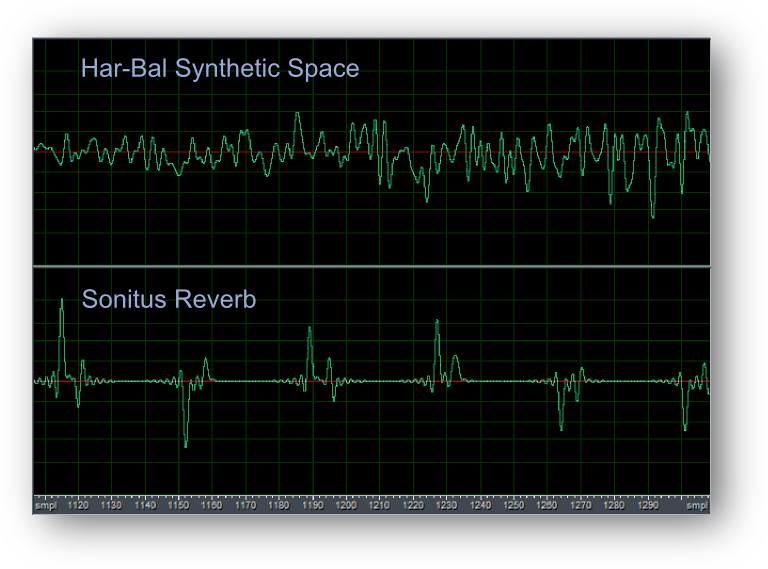Introduction to Har-Bal Synthetic Space, an AU and VST reverb plugin
 For the last 6 months or more I have diligently been working away at developing a new class of room reverberation plugin called Har-Bal Synthetic Space and is now nearing release. As a taster for what it is and how it functions I am including an extract from the product manual here.
For the last 6 months or more I have diligently been working away at developing a new class of room reverberation plugin called Har-Bal Synthetic Space and is now nearing release. As a taster for what it is and how it functions I am including an extract from the product manual here.
Introducing the Model
Synthetic Space began as an idea after having read a exceptionally well written article on building acoustics. The article http://www.church-acoustics.com/articles/auditorium-acoustics-101/ made plain the essential elements of good room acoustics (anyone interested should definitely read it). From that It became clear to me that the ideas conveyed therein could equally well be applied to the synthesis of virtual spaces and hence reverberation processing. Har-Bal Synthetic Space is the distillation of those ideas into a functional plugin format. The key points are as follows.
Signal to Noise Ratio
Any sound that detracts from the performer being listened to is regarded as noise. This could be environmental, electrical or reverberation based. Reverberation constitutes a noise source because it reduces the intelligibility of the performer. In a music recording the environmental noise and electrical noise sources will typically be very low but reverberation may not be. An idea level of signal to noise ratio for room acoustics is between 15 and 20dB (the reverberation level is 15 to 20dB below the direct arrival of the performers sound).
Early Reflections
Any reflected sound that arrives within the Haas zone (no more than about 70 milliseconds after the direct sound arrival) is perceived as being part of the performers sound and not an echo of it. As a consequence, early reflections do not reduce the signal to noise ratio. Put another way, you can have a lot of early reflections and generally not affect the intelligibility of the sound, although high levels can result in colouration.
Late Reflections
Late reflections are heard as an echo. If the reflected sound arrives later than 70 milliseconds after the performers direct sound but earlier than 250 milliseconds after, that reflected sound can cause confusion to the listener and severvely affect intelligility. Therefore, for a good sounding acoustic space late reflections should be supressed as much as possible.
Reverberant Tail
Ideally the reverberant tail should begin around 250 milliseconds after the direct path of the performers sound and the reverberation should be diffuse (perceived as comming from all directions and spread out in time). As long as the reverberation is not heard as discrete echos, it will add a sense of physical space to the performance and not distract from the listening experience.
The Model
Rather than attempt to model a real space, Synthetic Space is built on the notion of a simplified but idealized one. That space comprises a signal source, the performer, who is standing on stage a fixed distance away from the rear stage wall which is an idealized diffuser. The listener is in the middle of the open space between the rear stage wall and the far wall of the auditorium. The early reflections occur after a fixed time delay which is the time it takes for the sound to travel twice the distance between the performer and the rear stage wall. This distance is referred to as the Stage Depth. The time taken for the reverberation tail to begin is assumed to be the time taken for the sound to reflect off the auditorium wall back to the listener. Because the listener is in the middle of the room, this is the same as the time it takes for the sound to travel a distance equal to the Auditorium Depth, or the distance from one wall to the other. The idealised case of early reflections no later than 70 milliseconds and reverberant tail starting at 250 milliseconds corresponds to an Auditorium Depth of around 83 metres. For spaces larger or smaller than that these time limits scale proportionately. As such, smaller spaces (less than 83 metres depth) have the reverberation tail starting too early, and larger spaces have the early reflections continuing into the late zone. The model is implemented in this way to reflect the reality that the space you might want to realise is a real one of a given size rather than an ideal one, and ideal real spaces generally must be of a certain size to be constructed as such. The basic model idea is illustrated below.

Although late reflections are considered bad and it is possible to realise an indealised model that has perfect suppression of late reflections, it was found through many listening tests that the complete absence of late reflections (particularly with larger spaces) sounded unatural as the reverberation tail sounded disconnected from the sound source creating it. This was particularly true for strongly percussive sounds like drums and the like. To avoid this issue late reflections have been built into the model, albeit at a lower level to avoid significant intelligibility issues. This can be seen in the typical impulse response of a Synthetic Space as shown below.

Contrast this construction of reverbation to a more typical synthesised one and some differences become apparent. Below for example, is a comparison of Har-Bal Synthetic Space and Sonitus Reverb impulse responses for similar sized spaces. It is clear that Sonitus Reverb does not have a region of late reflection supression and not much initial delay. It seems that it is essentially just realising the reverberant tail part of a room response. On its own and in this configuration this reverb would not have the required auditory cues to convey the size of the space as the size of a space is conveyed by the delay between direct arrival of sound and the beginning of the reverberant tail and this impulse response does not have that delay present. This may explain why reverb processors are commonly used in a chorus-delay-reverb triplet configuration. The chorus effect provides the early reflections, the delay the spatial cue of the size of the room, and the reverb the reverberant tail. With Har-Bal Synthetic Space such a triplet is not required as it is built into the model itself. In fact, adding those parts would most likely ruin the synthesis.

Another point to note is the complexity of the room response that Har-Bal Synthetic Space realises. Zooming in on the early time region of this impulse response makes this difference apparent. In the case of Har-Bal Synthetic Space, the impulse response looks like a continuous noise like impulse response, whereas in the case of Sonitus Reverb it appears as a set of discrete reflections with silence inbetween. The continuous nature of these early reflections in Har-Bal Synthetic Space makes for a high level of apparent diffusion and the greater diffusion means the reverberation has less information in it to distract from the comprehension of the performer being listened to. In short it will have better intelligibility.

Har-Bal Synthetic Space is a stereo reverb that synthesises a three dimensonal reverberation. For stereo input material stereo is first converted to mono to ensure an even balance of left an right reverberation. The mono signal drives two uniquely seeded finite impulse response filters (FIR) that create the dense early reflections required for good diffusion. The outputs of both then drive independent and unique late reflection processors which finally drive the reverb tail processor. This component has left to right and right to left cross coupling to simulate sound bouncing around the auditorium. This structure is illustrated in the figure below.

I hope this clarifies what Har-Bal Synthetic Space is and how it differs from other reverb implementations. It has the impulse response complexity more typical of a convolution reverb but only has tiny CPU demands on the hosting processor, irrespective of the reverberation time. It continues to surprise me how natural the reverberation it creates sounds and how flexible and easy it is to use.
